|
FAQs About Turtle Identification
4
Related Articles: Turtles, Shell
Rot in Turtles, Amphibians,
Red Eared Slider Care,
FAQs on: Turtle Identification 1, Turtle ID 2, Turtle ID
3,
Related FAQs: Turtles 1, Turtles 2, Red Ear
Sliders, Turtle Behavior,
Turtle Compatibility, Turtle Selection, Turtle Systems, Turtle Feeding, Turtle Disease, Shell Rot, Turtle Reproduction, & by Species:
Musk/Mud Turtles, Softshells, Snapping Turtles, Mata Matas, Tortoises, & Amphibians, Other
Reptiles,
|
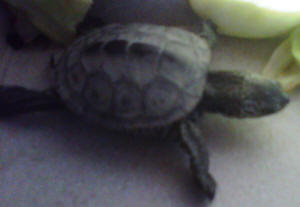
|
|
Turtle identification 4/5/20
Good morning . About three weeks ago I found this guy under my bushes. When
I spoke to him , he reached his head out curious and then approached me. He
has been living in my yard since. Seemingly happy. I have no idea what he is
eating . I have offered every kind of fruit, vegetable. If anything he is
catching the fruit flies that gather on them. We have a man made lake across
the street. I live here 36 years I have never seen a turtle on this side. I
think he was a pet considering how friendly he is. Can you identify for me
so I can care for him ( actually I think its a girl) properly.
Thank you for your time
Jackie
<Definitely a slider of some sort, either a Cooter (such as Pseudemys
coccina) or else a Yellow Bellied Slider (Trachemys scripta). Telling them
apart isn't especially easy, but the green blotches on the front of the
plastron are more similar to the Yellow Bellied Slider. Both species can be
kept as pets, in much the same way as Red Ear Sliders, as here:
http://www.wetwebmedia.com/FWSubWebIndex/RESCareBarton.htm
http://www.wetwebmedia.com/FWSubWebIndex/redearsliders.htm
Older specimens like this one are more herbivorous but they are omnivorous
for sure. Koi Pellets make a good staple. If kept indoors, UV-B lighting
will be essential, otherwise you'll find yourself taking an expensive trip
to the vet sooner or later. You can get very convenient combined heat/UV-B
lamps that do a great job! No need to heat the water, but a filter will help
to keep it clean (these animals poop underwater, which gets messy real
quick). Cheers, Neale.>
|
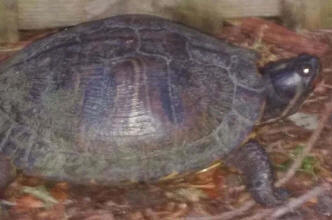
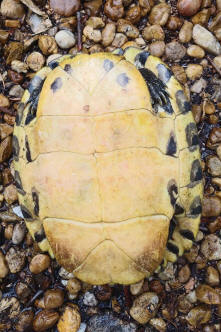
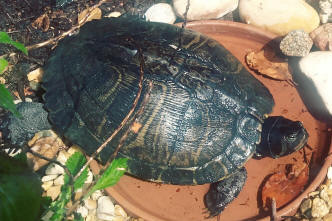 |
|
Re: Turtle identification 4/8/20
Thank you for your email. I just have a few questions. This possible slider
is at least 14 inches .That bowl is 12 inches. Do they really get that big?
<Yes, they can. Like most reptiles, and unlike mammals, they will grow until
they die. So you can get exceptional sizes, though Sliders tend to max out
at around 20-30 cm/8-12 inches. Cooters can get a little bigger.
Bear in mind these nominal sizes are the shell length, not head to tail
tip.>
Your article says 8 inches.
<Shell size. Now, I'm not 100% sure on my identifications. So some homework
for you! Firstly, does the turtle have webbed feet (often with long nails)
or robust, rounded feet (often with blunt claws). If webbed, then for sure
he's an aquatic freshwater turtle, what in England we'd call a terrapin. If
he has robust feet, he's what we'd call a tortoise, meaning he doesn't go
into the water. Check this first. Freshwater turtles of North America are
all much of a muchness in terms of care, with the exception of Snappers, so
while you might not ID the species, you can be fairly comfortable with
regard to size, diet, behaviour, etc. Terrestrial turtles, i.e., tortoises,
are invariably herbivores with a taste for carrion given the option, so need
a plant-based diet with fresh greens of various kinds, plus occasional meaty
treats.>
I ordered a 36 inch pool to put in the yard. I thought I would dig a hole
and put it in so he/ she can get in and out easily.
<Very important. Also, if you plan on keeping this as a pet, will be a
secure fence to both keep him in the pond area, but also to keep predators
out. Foxes, raccoons, dogs, etc. will all have a go at a Slider or Cooter
given the chance.>
Possibly get a filter down the line if he / she likes it.
<Depends on the size of the pond, but yes, if you want to see more than
murky water, a filter is useful.>
If not I guess I should bring him / her to a lake or river.
<Agreed, that's usually the best thing with wild-caught animals. Getting in
touch with your local Fish & Wildlife agency can be helpful, or a university
with a local biology programme. Some reptile shops offer good advice, too.>
I do have to say it really seems happy here. It comes right up to my dog
when she is out there sun bathing. It has been a good distraction for all if
us being stuck home.
<I would imagine!>
I just don't want to bring it any harm. Other than koi pellets do you think
minnows would be a good idea?
<A bad idea. Minnows are (a) not their natural diet; and (b) full of fat and
thiaminase. Sliders and Cooters, indeed, most American freshwater turtles
apart from Snappers, are omnivores that become more herbivorous as they age.
Short term, things like white fish fillet, earthworms, shellfish, even beef
heart with the fat removed can be used to entice a turtle into feeding. They
also enjoy all sorts of aquarium and pond plants, including good old
Elodea.>
I really don't know what it is eating now. I have offered every fruit and
vegetable. I guess he just living off the land. He has the whole yard to
roam. I am sure there are lots of bugs. Any advice?
<In a garden pond turtles will indeed live largely off the land, as you say.
But do read the previously linked articles re: feeding, because these
animals are really not difficult to feed.>
Thank you for your time.
Jackie
<Welcome. Neale.>
|
|
Wondering what kind of turtle we have
1/13/19
<<Sara, howsit?
> Please re-size and re-send your msg. The pix files are too large. Kbytes
please, not Mega. BobF>>
Not sure how to do that.
<This is as good as any!>
Let me know if these worked
<Looks fine to me. In any case, the turtles seem to be Yellow Belly Sliders.
Lovely animals, for all practical purposes identical to Red Ear Sliders in terms
of size, care, behaviour, etc. I kept one of each in the same tank, and the
(yellow) male would even try to mate with the (red) female. Cheers, Neale.>
|
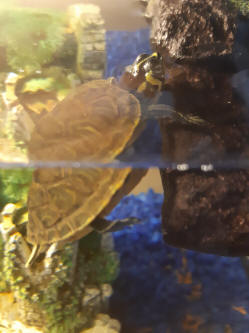 |
|
Re: Wondering what kind of turtle we have
1/13/19
Oh cool! Thanks for getting back to me! So the yellow ear makes it a male?
<Nope. It's a whole separate species.
https://en.wikipedia.org/wiki/Yellow-bellied_slider
Just observing that I kept a male Yellow Belly Slider with a female Red Ear
Slider and they got along as well as two turtles ever do.>
Appreciate your expertise!
<Glad to help. Neale.>
Re: Wondering what kind of turtle we have
1/14/19
Oh okay yes I have Googled more about our little one now. They are cousins v
similar :) do you have any tips on telling age?
<Not really. They're not easy to age. Maximum size is around about that of a
dinner plate, which they get to in around 5-6 years. Cheers, Neale.>
Re: Wondering what kind of turtle we have 1/15/19
Thanks Neale.
<Most welcome.>
Apparently he was had by previous owner for just over a year now.
<Sounds about right.>
Still seems really small from what I thought anyways.
<Growth rate varies, and oftentimes females grow slower than males.>
Can the tank size or amount of water make this difference?
<Not much of a difference with turtles. Maybe a little bit. But so long as
they're given enough food, and sufficient variety, they tend to all grow to near
enough full size. Expect anything between 20-30 cm for most of the common
"slider" species we keep as pets. Some variation, just as with humans, but none
of them are pocket-sized.>
He was in a 30 gallon when I got him but there was only a couple of inches of
water in it, sadly. Im not sure if he ever had much room to swim. Now that I've
mostly filled the tank, he doesn't use his floating rock to bask much ...
<Indeed. Basically, these turtles use land to warm up (under the heat and UV-B
lamp/s; the combined lamps are ideal) and then feed, cool down, and crucially,
defecate, in the water. Many species hibernate underwater too; in the wild at
least. Cheers, Neale.>
|
|
ID Confirmation Please 7/24/18
I walked out the side door of my garage this morning and found this pretty lady
next to the concrete pad. Her gender became apparent when she started laying
eggs right then and there. I think it might be a Chicken Turtle, but I'm not
sure. I thought it also looked like a Suwannee Cooter. We live on the eastern
coast of Florida, but not close enough to water though. I went back inside and
took a closer pic of her shell and eggs from a window.
After I got the message composed, I went back outside to possibly get a better
picture of her face, but she had disappeared. I don't know if the eggs will even
make it through the night because we have lots of critters around here:
raccoons, armadillos, etc.
<Apologies for late reply; our turtle experts seem to be out of town, so you've
got me instead! Neither photo is really clear enough to be sure, but your
suggestion that this is a Chicken Turtle (Deirochelys reticularia) is not at all
unreasonable. But I'd also wonder about a Musk Turtle, Sternotherus spp., or Mud
Turtle, Kinosternon spp., though these are generally much smaller than
Deirochelys (around 10-15 cm versus over 25 cm). Now, when it comes to the eggs,
I agree, these are unlikely to survive 'just left there'. It might well be that
you can put a cage or box over them in the short term, but I don't know if it is
legal to actually collect the eggs and store them safely. Moving reptile eggs is
not trivial, because
if they are turned upside down it can prevent them develop. Refer to a local
animal rescue centre for help here. Meantime, I'm cc'ing our turtle experts in
case I've overlooked something. Good luck! Neale.>
|
.jpg)
.jpg) |
|
what type of turtle is it? 9/19/16
hello i live in Indiana, i found a turtle a couple weeks ago almost dead i
took him and made a house for him or her. i think he's a boy so i named him
Trent. I've been doing research and all i have found id that he is a
snapping turtle but that doesn't make sense. i get him out of his cage
everyday and he lays on me crawls in my hand even my little 5 year old
brother holds and plays with him with adult supervision. he has never bitten
or anything. even a dog tried to eat him all he did was crawl away. i love
him or her to death. can you please tell me what type of turtle he is and
what his habitat should be like and what he should eat because i don't want
to do any harm to him. (no i don't release animals back into the wild they
have a better chance of survival when i take care of them) please let me
know asap! thanks!!!!
<What you have there is a common snapping turtle (Chelydra serpentina).
They make interesting pets, they can thrive on plain old ordinary Koi
pellets without the need for any kind of live food.
There are only three warnings
1) They can bite fiercely and strike almost anywhere around the front HALF
of their body, so the only way to hold them is by the tail with fingers
support the rear of the shell
2) They have a really short temper which means warning#1 is nothing to
forget about
3) They get REALLY big and then you have a huge, unwanted, dangerous animal
on your hands. DarrelL>
re: what type of turtle is it? 9/19/16
Thank you for contacting WetWebMedia. We appreciate your email, but
unfortunately cannot reply because it's in a format that we can't post on
the site. Please correct your grammar, punctuation, and spelling, make sure
the question isn't written in ALL CAPS or no capitalization at all and send
it to us again. We aren't trying to be the "bad guys" here, but we are ALL
volunteers, and we get dozens of questions every day - we just haven't got
enough time to correct questions that aren't formatted properly. Please take
some time to fix your question and write back; we will greatly appreciate
this respect. Thank you,
Gabe
<Gabe; am wondering if the writer here is a child. I/we try to make wide
allowance for children, non-native speakers and folks of apparent diminished
capacity. I sent this along to Darrel, and he has responded.
BobF>
|
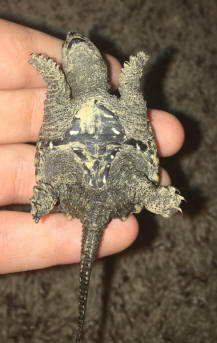 |
|
Turtle ID 8/26/16
I’ve been searching everywhere and can not figure out what kind of turtle
this is. a lady didn’t want it. So I took it but she didn’t remember what
kind of turtle it is. I have it in a 10 gallon tank but I want to make sure
its not going to get too big.
<Much bigger. Its shell will get to side plate size -- 20 cm/8 inches long
is about average.>
She said she's had it for a couple months. He goes from the water to the
land and he eats his turtle food. I just want to make sure I’m not supposed
to do any thing extra for it that I’m not already doing. thanks
<Looks like a Yellow Belly Slider to me, but I've cc'ed our turtle guy just
in case I'm wrong. Certainly a slider of some sort, anyway! Basic care will
be identical to that of the Red Ear Slider, as described here:
http://www.wetwebmedia.com/fwsubwebindex/RESCareBarton.htm
Do understand "turtle food" is actually not a very good staple for them.
Okay as a treat, but a mix of green foods, koi pellets, and occasional bits
of fish or seafood from the kitchen will work out much better. A source of
calcium is required too, plus UV-B lighting. Other than that, these sliders
are easy to keep, but unfortunately, like all reptiles, easy to kill too if
you neglect the essentials like UV-B and calcium. Cheers, Neale.>
|
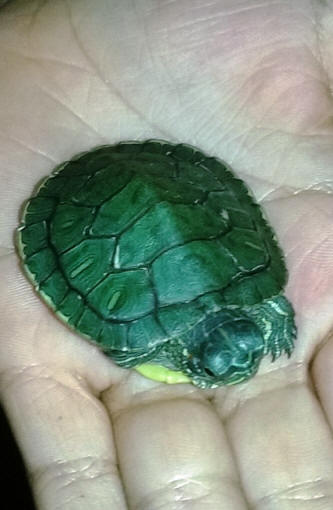
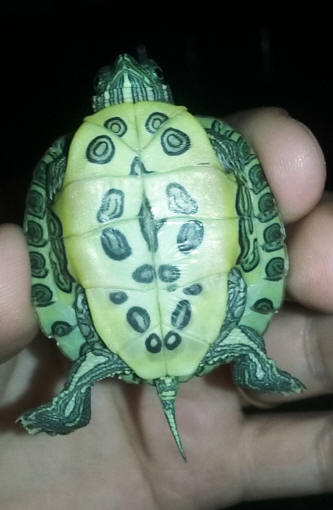 |
|
Turtle ID; comp. 4/9/16
Hi my name is Lisbeth
<Hiya Lis -- Darrel here>
and id recently found a turtle with a friend of mine
and i already have a turtle so we thought i should keep it but the turtle i
have is a Mississippi map turtle im sorry if I've misspelled it but i was
just wondering if it was okay for them to be kept together the turtle we
found is a baby but i don't know exactly what kind it is I've attached a
picture maybe you can help me identify it and answer my question about
keeping them together that would be so helpful.
Thank you!
<What you have there appears to be a Red Bellied Slider and they are as cute
as they come>
<From a care standpoint, they're virtually identical to the Red Eared
Sliders and their family>
<The MAP turtle is very similar in terms of care and diet, etc. but requires
a few extra considerations:
Water quality should be tip-top. Keep it clean and change it frequently.
Map turtles are more likely to develop skin of shell conditions from poor
water quality. Next, because they are more shy and nervous, they really
appreciate rocks and plants and other things they can hide behind or under
when they feel the need. Other than that, those two will do fine together>
|
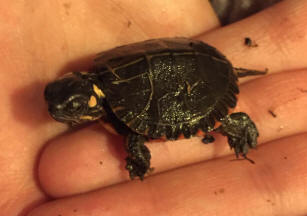 |
|
Help me identify this turtle 1/15/16
Dear Crew,
<Hiya, Darrel here>
Can you identify this turtle?
<Her name is Brandett, daughter of Elvin and Maxine Chelona from Duncan, OK>
It was in Southwest Oklahoma near a highway in Altus Oklahoma
<She attended OSU for a few years but couldn't keep up with the hectic pace so
she dropped out and just drifted for a while>
No .. I mean .. what KIND of turtle is this?
<Oh. Hmmm. The gold/tan color is unusual. The pictures, as best I can see,
indicate she is a hard shelled water turtle but they are usually green/olive
drab to black, so it's a bit confusing.>
<Could you send a picture looking straight down from the top and another
straight up from the bottom? Since we don't need to publish these pictures ...
the bigger the better>
|

 |
|
Help me id turtle 8/21/15
Dear Crew
<Hiya -- Darrel here>
My husband found a turtle on the road it's shell was covered in thick algae can
u tell me what kind of turtle it is? Its about 8 inches and i have gotten some
of the algae off
<Well, Izzy - what you have there is an adult Western Chicken Turtle. The long
nails on the front claws suggests that it's a fully grown male. Males more than
females are often found crossing roads and travelling long distances to find new
homes.>
<You might check with the wildlife agency in your state to see if it's a
protected species.>
|
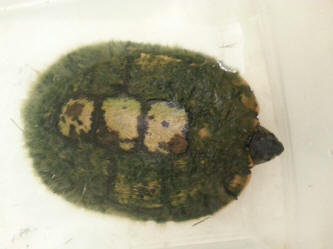
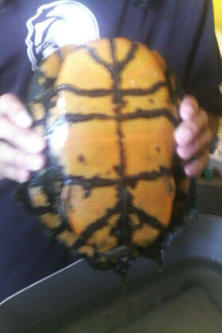
|
My turtle is still tiny... 3/17/15
Hello! About a year ago I found a tiny little turtle in my friends yard. I
THINK he is a snapping turtle. He has a really long neck when
he extends it and he is a feisty little thing.
<Hmm... a photo would help... there are various other long-necked turtles...
Florida Softshells for example. Most long-necked turtles tend to be more
predatory than the common Sliders, and potentially much more dangerous to you.
Do get a photo, send to me, and I'll do my best to ID.>
He was about the size on a quarter when I found him. He lives in a 10 gallon
tank with rocks in the bottom, some fake plants and a rock for him to hide
under. He seems happy and healthy, but he hasn't grown very much (maybe the size
of a silver dollar). He still eats the baby turtle food because I feel like the
adult food is too big for him. I also give him some dried shrimp but he doesn't
seem to like them much.
<Indeed not. Without identifying this beast, it's hard to say what his diet
should be. Short term, try offering slivers of white fish fillet or live
earthworms. If he goes for these, he may well be a carnivore, in which case
pellets aren't the best diet. Indeed, pellets aren't much use for turtles across
the board, despite their wide sale.>
I am wondering what I can do to help him grow or if he is on track?
<He is definitely undersized if he's still coin-sized a year after collection.
Do let's see this chap! Cheers, Neale.>
|
TURTLE HELP!!! 7/21/14
Soooooooooo,
<Hiya - Darrel here>
I got a turtle and I have no idea what species it is.
<Looks to me like you have yourself a Pelomedusidae which is a fancy way
of saying an African Sidenecked Turtle.>
I looked at all the websites and I couldn't find one. I need help
because he does this thing where he gets on the log at the bottom of the
tank and he circles it. He keeps circling it. He never did it before.
Should I be worried?
<Nope - he's just active>
I attached to pictures, if you can help me please email back. I don't
know if I should be worried. He's the only one in the tank. I have a
heater, basking dock, filter and decorations in the tank. And if you
could tell me what species he is as well, that would be appreciated.
<The side necked turtles are more aquatic than most, so they appreciate
clean, deep water, but they also need a basking site that provides both
heat and UV-B lighting. Enclosed is the basic care instructions for the
Red Eared Slider -- ALL of which is relevant to the Side Necked
turtle as well:
http://www.wetwebmedia.com/FWSubWebIndex/RESCareBarton.htm>
Thank you.
<Yer welcome. I can't say for SURE … but I think his name is Smiley>
|
.JPG)
.jpg) |
|
Re: TURTLE HELP!!! 8/6/14
Hey, It's me again.
<That's funny - it's me TOO! (we got to stop meeting like this)>
Serious question though don't laugh but can turtles get aroused?
<Yep - that's where baby turtles come from>
I know it's weird but I swear my turtle has started almost it looks like his
humping the log.
<That's not usually how it looks. You might check to make sure he's not got
lose skin on his limbs>
I just need to know if I should be worried?
<Not really. Not unless he gets to your computer late at night and starts
surfing the web for turtle pictures and then trying to explain it as
"research">
Thanks for not judging.
<No problem>
|
|
Please identify this turtle 6/18/10
Dear Crew
<Hiya! Darrel here>
My friend in Alaska got this turtle 10 years ago from someone in
an apartment and was told it was at least 10 years old then. So I
assume it was a pet before he got it. He doesn't know what
type it is but has had it in an aquarium with a small pond and a
hiding place and light bulb/heating lamp and feeds it the likes
of mixed vegetables and I'm not sure what else but seems
healthy and happy...as far as I could tell. But for the life of
me... and he never could find out what kind he is...the
"bill" he has...I have no idea how that formed or if it
is the nature of the species but it is hard but thin...like a
toenail...perhaps. His nostrils are above his bill.
<What you have there Laurie '¦ is a 1971 Plymouth
Duster with the 340 cu V8 engine in front of a factory 4 speed
heavy duty transmission '¦'¦>
<Oops, wait '¦ wrong forum>
<Laurie '¦ what you have there is a very unusual
version of a very common animal. That there is a 3 toed Box
Turtle (Terrapene triungis) that is very, Very, VERY badly
misshapen. Without doubt a birth defect from a poorly formed egg,
as you can see if you compare any photos of a 'normal'
box turtle. In the egg, turtles and tortoises develop
"folded over" at the waist '¦ in essence
folded in half. As they grow they straighten out and the plastron
(bottom plate of the shell) is flattened to be "normal"
as you can see in Louise there, her bottom didn't fully
straighten out and is now a bulge.>
<This is one more testament to how resilient our turtle
friends are. Louise (and I just made that up, I have no idea what
her name is - or even if it is a "her") will live a
fine & happy life in spite of some fairly severe
differences.>
<Box turtles are terrestrial, Laurie. It's possible that a
3 toed box like Louise may never actually get to swim in anything
we'd call deep water. Her enclosure should be primarily land
with moss, wood chips and maybe even sand as a substrate with
just a dish of fresh water to bathe in. Normally they start out
as carnivorous as babies, feasting on worms and grubs and
whatever else they can catch -- and becoming more vegetarian as
they age.>
<Now you can look up all kinds of information on Terrapene
triungis and get lots of specific information about her care
(her?? There I go again!!) but at the same time keep in mind that
nothing succeeds like success '¦ whatever your friend
and you have been doing for the last 15-20 years has allowed
something nature would have discarded to survive and even
thrive!! Congrats to both of you!!>
Thanks, Laurie
<Yer welcome Laurie!!>
<Now '¦ I wonder if I told the guy with the
Plymouth to feed it worms and melon and dip it in water twice a
day '¦??>
|
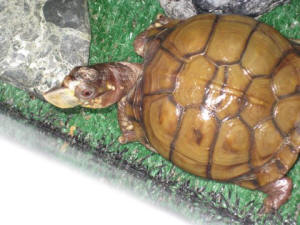 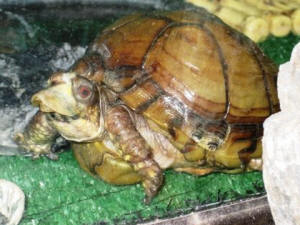 |
3 baby turtles, ID, sys./fdg., hlth.
4/3/13
Dear Crew
<Hiya Taylor - Darrel here>
I was given 3 baby turtles this past Christmas and was told that they
are red eared sliders but they do not have their red ears yet.
<That's not entirely accurate. They are born with the red patch on
each side, so they are most likely not Red Eared Sliders.>
<The genus' Pseudemys & Trachemys comprise a wide variety of turtles
including the painted turtles, the sliders, the Cooters, and others -
and for our intents and purposes as pet keepers, they are all the same -
they have the same requirements.>
<So, assuming that they look in every other respect just like a Red
Eared Slider, then they are probably Trachemys scripta scripta - the
yellow bellied turtle.>
I put the three small turtles in a 10 gallon tank and they have almost
quadrupled in size. I will soon be getting them a much larger tank. What
I was wondering though is how am I suppose to regulate the amount of
food that each of them receive?
<Feed them all they can eat in 5 minutes about 5 times a week.
Reduce that to 3 times a week once they are about the size of your fist>
I feel as though two of them are bullying the other one so that one is
not getting as much food as it needs.
<That happens all the time. Take the little guy out, put him in a
shallow bowl of water (enough that he can stand it and put his head out.
Give him perhaps 10 minutes to calm down from the change - and then feed
him separately. If you do this at least twice a week,
you'll know for certain that he is getting nutrition>
Also they "beg" for food every time I walk by and I am never sure when
they are actually hungry and I do not want to over feed my turtles.
<Taylor - overfeeding is the single biggest health problem in our pets.
Because WE feel good when we eat and because we want our pets to feel
good - we feed them. Too much and too often.>
One more thing, how do I tell when they get stressed out?
<The first thing you'll notice (unless you see a physical injury) is a
change in behavior. A turtle that swims like crazy against the
glass when you walk into the room - now sits on his rock and just
watches. Or a turtle that swims when you ever the room now swims
ALL the time … like he can't stop. Changes in their normal
behavior. Now, a change doesn't always mean a problem, so
once in a while it's OK. Like ONE day he just doesn't jump in the
water to see you … should make you notice and wonder. TWO days and
now it's time to see if anything is wrong.>
<Here is the best guide on the planet. Read, learn, understand and
DO everything it says - and your little guys will be fine!
http://www.wetwebmedia.com/FWSubWebIndex/RESCareBarton.htm >
|
Unusual Exhibit at The Singapore Science Centre
4/3/13
Bob
We brought our nieces to the Singapore Science Centre and came across this
Pig Nose turtle on display. It was confiscated from smugglers by the
local authorities. Sorry for the blurry pic. The turtle was hiding in a
hard to photograph corner
<Thanks for sharing Perry. BobF>
Perry
|
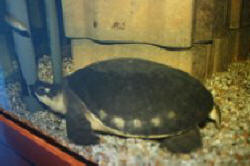
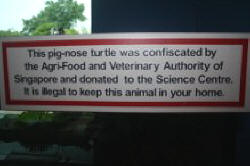 |
|
Singapore Science Centre turtles
4/3/13
Bob
They have a Star turtle from India as well. I feel sorry for these
critters. They are going to spend the next 20 years in a little corner
of the Singapore Science Centre
<Aye ya. BobF>
Perry
|
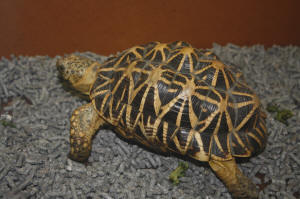 |
|
My new turtle, ID, care - 1/25/13
Hello
<Hiya>
I'm sorry for disturbing but I'm really having trouble caring for my second
turtle.
<Sorry to hear that>
My first turtle is a red slider and she has been really lovely since I
brought her but then I brought another turtle that I don't know what it is
(I attached a picture of her)...
<What you have there is a Trachemys scripta … a slider, just not a
Trachemys scripta elegans (the Red Eared Slider) -- looks more like a yellow
bellied slider from here>
<The good news is that the care is EXACTLY the same as for a Red Eared
Slider and they get along fine>
First it didn't go in the water but after a while she started to get in the
water
<It was just nervous>
But then I noticed something orange starting to form in her tail, legs and
neck. And her shell started to get a bit of white.
*note: the orange thing is not showing in the picture because the picture
had been taken a long time ago and I noticed the orange thing these weeks*
and in the place I live there is nothing for turtle no vets or even shops so
I couldn't provide a vet care for the turtle so if u can please see what is
my turtle and tell me if the orange thing is okay or not and if I have to
separate her from my other turtle.
<Orange is not a color normally associated with any disease. It's
normally a stain from contact with something like a brick or a rock that is
in or near the water. Try cleaning the areas with some white
vinegar and a cotton swab or towel. Same with the whitish area on the
shell.>
<The WHITE is often one of two things: a fungus infection, which is
not a good thing … but more often than that, it's just mineral deposits from
the water. Clean it with the vinegar and see how well it comes off>
|
.JPG)
.jpg) |
What species is my terrapin? 10/31/12
Hi! I'm Jess and me and my mum have a pet terrapin called Squirtle who
we think is a female. We got it from a friend but we don't know what
species she is. She said her dad got it from the Middle East after he
came back to England. We think she's only a juvenile because she's only
about 3 inches long and she's 3 years old. We've checked loads of
books and websites but there aren't any terrapins or turtles that look
like her. She has a black carapace, a yellow plastron, a short tail and
a black neck and face with yellow stripes. We just want to know what
species she is so that we know exactly what we need to care for our
terrapin.
We hope you can help.
Could you please send two or three pictures of Squirt? Out
of the water and from different angles?
|
Identifying a turtle
9/13/12
Dear Crew,
<Hiya - Darrel here>
I recently came across a baby turtle during hurricane cleanup in
Mississippi, so I'm not sure if its even a land or water turtle. I'm
attaching a picture in hopes of someone being able to identify it so I
can provide it with proper care.
<Kayla - what you have there looks like a baby box turtle … just about
THE coolest land turtle there is. I'd like to see a side view and one
from 3/4 toward the front just to be sure … BUT from here it looks like
a Terrapene carolina. Lost of documentation on them on-line, great
personable pets!>
Thanks,
Kayla
|
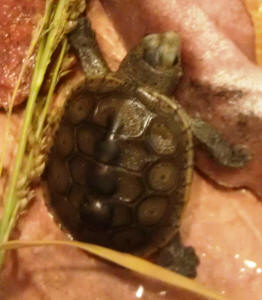 |
|
Turtle identification 9/7/12
Hello.
<Hiya - Darrel here>
I recently rescued this turtle from a 12 year old who had it living in
its own filth, in a Tupperware container.
<Well now, Keira, a 12 year old living in his own filth is not that
unusual. They really don't even see dirt until enough of it has
clumped together to support commercial agriculture. The
unusual part is a 123 y.o living in a Tupperware container>
<OH … wait …. You meant the TURTLE, didn't you?>
The turtle obviously has horrible shell rot. After researching aquatic
turtle care on your site, as well as other sites, I dry-docked the
turtle for 2 weeks and cleaned his wounds with vinegar daily. I also
changed his diet to Tetra brand ReptoMin floating food sticks with
calcium and vitamin C. I also provide an occasional krill or earthworm
as a treat.
<So far - perfect!>
I just set up his new habitat (in a 40 gallon aquarium) and introduced
the turtle back to an aquatic habitat, with a dry docking area, a
basking bulb, UV lighting and water filtration. I have researched
everywhere I feel I possibly can to find out what kind of turtle he is
and I can't find any turtle that looks anything like him. Can you
identify the type of turtle he is?
<well - totally because of you, I can positively identify this turtle as
a STILL ALIVE turtle!!!!>
I want to make sure I'm giving him the proper care and nutrition for his
species.
<The pictures you sent are great, but between what could possibly be
some shell damage and not knowing where the turtle came from, it's a bit
harder to say than you’d think. I'm leaning toward describing it
as a Deirochelys … the Chicken Turtle. And as long as
we're in Good News mode - they are notorious for bacterial shell
infections!>
<The chicken turtles are a bit more terrestrial than the sliders &
Cooters, etc. My ideal for a Deirochelys is a larger land-based
enclosure with a large, but rather shallow tub for a pond.
Now, I realize that sounds complicated but it isn’t really.
If you took a 50 gallon show aquarium and placed a 24 inch x 12 inch
Tupperware pan that has been cut down to a 6 or 7 inch height in one end
(with a ramp of some sort) & fill the other with peat or potting soil,
etc. he'd have a 50/50 enclosure. Place the basking lamp as
far away from the water as possible and the UV lamp right in the center.
In short order you’d find where he likes to spend most of his time and
you can adjust the proportions accordingly.>
Do you have any advice for me to further make this turtle as happy as he
can be?
<Generally speaking, turtles are easy to keep happy. They don't
need IPods (no ears) and they CAN'T be allowed near computers (they have
no sense of self control when it comes to on-line shopping), usually
they don't need much more than food, water, lighting, heat & basic cable
TV.>
I appreciate your time, and I love your website, it's helped me with
more information than I could ask for.
Thank you,
<Yer welcome>
Keira
|
.jpg)
.jpg)
.jpg) |
Please help me to identify my little buddy
5/26/12
Dear Crew
<Hiya - Darrel here>
Can you please help me to identify my turtle? My children found
him in September in the cold rain, I believe he was just hatched, but
needless to say, I have fallen in love with his little turtle face!
<They are neat, aren't they?>
I believe he is healthy, but would like to know what kind he is, so I
can better care for him.
Thank you so much,
Jenna, Michigan
<Jenna - what you have there is possibly THE coolest turtle on the
planet!! It's a Terrapene carolina … a Box Turtle.
They are fun, friendly, develop distinct personalities, inquisitive and
easy to care for.>
<They're not water turtles, per se. They live on land, usually
NEAR water because they do like to swim. They mostly eat
snails and worms as babies and juveniles and then transition to more
fruits and vegetables as they get older. Just make sure, if
you feed him snails, that there has been no snail-bait used.>
<For now, he belongs in the terrarium-type setup. I make mine
starting with a long plastic storage box from a building supply store …
you can use actual peat moss on the floor if you want, but I usually buy
a couple pieces of indoor-outdoor carpet (not the stuff that looks like
fake grass) and put that in the bottom, then I place some tiny potted
plants in various places. He requires a source of UV-B and this
can easily be accomplished with a Reptisun CFL bulb from Zoomed and a
plain ordinary clamp-lamp with reflector that you get at the building
supply store.>
<He'll grow slowly and as he does his shell will start to become much
more domed. He's likely to live over 80 years, too!>
<The only thing to warn you about is that they can tend to fixate on one
kind of food and ignore everything else. I had a box turtle named
Bud that decided he wouldn't eat anything but strawberries.
It is a difficult habit to break.>
<Have fun - that little guy will be pleasure to have!> |
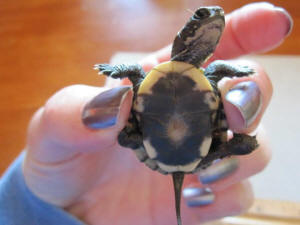
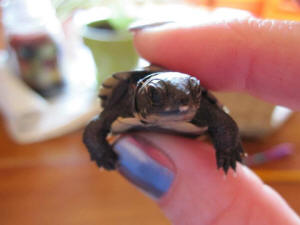
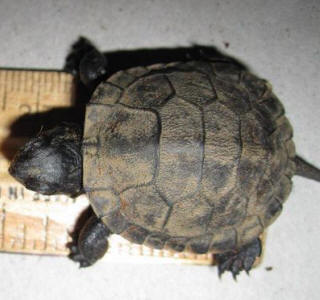 |
|
Turtle Identification 3/1/12
Dear WWM Crew,
<Hiya - Darrel here>
Please help me identify my turtle.
<His name is Gary. He's the son of Odman and
Clara Scmitterman>
I made the mistake of asking our local pet shop when we first
acquired the turtle from my father-in-laws golf course. However,
I have never been sure that they were right (they said yellow
belly Cooter)
<Wow! They're not only NOT right … the only way
they could have been more WRONG is if they told you he was a
toaster-oven>
and am afraid that my poor turtle may not have the proper
conditions he needs, in fact I found him at the bottom of the
aquarium almost dead from drowning this morning.
<He's a land turtle!>
He has a heater, turtle dock, UV light, and filter in his
aquarium but honestly all my research makes me think he is not
even a water turtle. Thank you so much for any advice you can
give me. My girls and I love Squirt very much but I don't
want him to suffer because they wanted him as a pet.
<Sorry it too so long to get back to you, Bree. I hope
Gary is OK>
<Gary (or whatever you named him, is a Box Turtle
(Terrapene carolina). They are some of the cutest
and friendliest turtles around - and there is much information
about them.>
<To start, they live on land. They do swim sometimes,
but usually just soak in shallow water. His enclosure
would be a solid floor covered in anything from newspaper to dirt
or peat or even that indoor-outdoor carpet (it looks nice being
green & all and you can take it out & wash it in the
sink!)>
<He needs a heat lamp over part of his enclosure, but not a
tremendously hot one (I used a normal 60 watt incandescent bulb)
and he needs a UV-B lamp - the kind used for water turtles is
fine.>
<A shallow bowl of water that he can climb into and soak in is
good>
<Food-wise they eat snails, worms, grubs as well as fruits and
veggies. As a youngster he'll tend more toward
the snails and worms. I feed my young ones am
earthworm or two every Saturday morning (Pet stores carry
earthworms called night crawlers) and I offer a melon piece or a
carrot end & top every Wednesday or so.>
<One thing they tend to do is "fixate" on one food
and refuse all others. I had an adult Box turtle that
fixated on strawberries and wouldn't eat anything
else. It took years to get her back to eating regular
foods>
Thanks,
Bree Scott and daughters :)
<Yer welcome!>
|
|
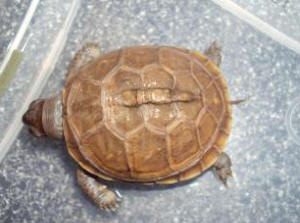 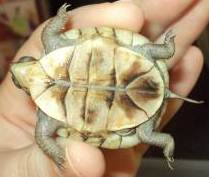
|
|
What breed are my Turtles/ Terrapins?
10/26/11
Hello,
<Hiya - Darrel here!>
When I first got my turtles in April (they were six weeks old
then) I was told that they were Yellow Bellied Sliders (I never
really believed the shop owner, he didn't seem to know much
about them or keeping them). I posted photos of them on a forum
and was told that they were Red Bellied Cooters.
<OK>
I came to WWM a while ago, to ask a question and was given great
advice, and so I'm back again. :)
<Yeah - but THIS time you got me rather than Neale or Sue
'¦ so the odds on getting more great advice is
dicey>
I would really like to know what breed my turtles are, for
obvious reasons.
<Because you want to race them?>
I know a lot about Yellow Bellied Sliders but have tried to find
information on Red Bellied Cooters and am having a bit of
difficulty, so, if they are Red Bellied Cooters could you please
tell me if they are like YBS as that is what I've been
treating them as for the last six months and I hope that it is
ok.. I have attached some photos which I hope will be sufficient
enough for you to tell what breed they are.
<Nice pictures.>
<Caralyn, you came to the right place. Here's what you
need to know:>
<SLIDERS are green & yellow. Green shells (as hatchlings)
with green and yellow skin.>
<COOTERS are black & yellow. Black shells with mottled
yellow smudges and with black and green skin.>
<So what you have there are some cute little Cooters
(Pseudemys concinna). Now as far as being RED BELLIED Cooters
(Pseudemys concinna rubriventris) my guess is NO and the reason I
say that is the red bellies usually have red or reddish-yellow on
the underside of their carapace before it meets the bottom
(carapace) and these don't.>
<For that reason, I believe you have Pseudemys concinna
concinna - the Eastern River Cooter>
<Now for the good news: All of the Sliders, Cooters, Red
Bellies, Yellow Bellies, Chicken turtles and all their aunts,
uncles, cousins and kids all need EXACTLY the same care & the
same diet, & the same '¦ everything!>
Thank you in advance
Caralyn Hosler
<Yer welcome!>
P.S. I live in the UK (I don't know if this will make a
difference).
<Well, YOU live there so I imagine it makes a great difference
to you. Me? Not so much. As far as the TURTLES are concerned, it
means only a few things:
1) You have to call them terrapins and not turtles, otherwise
Neale gets upset
2) You have to teach them the metric system, because they were
born in the Olde Imperial system
3) On their birthday, you need to play a southern movie on the
telly for them - something like Smokey and the Bandit (but for
heaven's sake do NOT watch that yourself!!) - So they'll
remember their heritage.
|
|
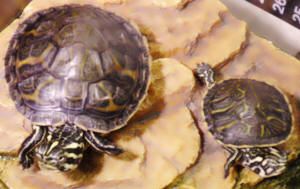 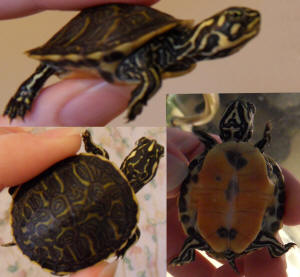
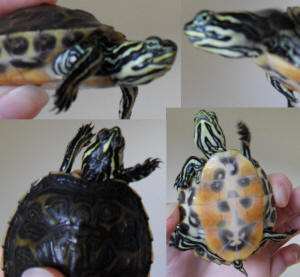
|
|
Re: What breed are my Turtles/ Terrapins?
10/29/11
Hi,
<Hiya>
Thank you for your help. I really appreciate it. As always funny
and informative. :)
<SO '¦'¦.A grasshopper goes into a bar
and he hops up on a stool and he orders a beer>
<While he's sitting there, the bartender walks up and
tries to make conversation. He says You know '¦ we
have a drink named after you!>
<and the grasshopper gets all excited and replies
"Really??? You have a drink named Melvin?>
Thanks
Caralyn
|
|
I have a question.. 10/13/11
*Hello,
<Hiya - Darrel here>
I was driving down the road today and witnessed a truck almost
hit a turtle that was crossing the road.. My niece instantly fell
in love with it and wanted to keep it.
<I understand>
Im just wondering if you can identify the species of turtle it
is, and what to feed it..
<Yep - it's a Box Turtle!! (Terrapene
carolina) and one of the coolest, neatest, personable
turtles you can possibly have.>
<They like to swim, but they live on land '¦ can be
very happy in a fenced garden, patio, etc. But I've even had
them as house pets as long as you don't have a toddler to
drop them or a dog to try to play with them - anywhere she's
not likely to get stepped on.>
<At that size, her diet is mainly veggies and fruits, but they
like snails and earthworms if they can get them. If you feed her
snails, make sure they're not from a garden that uses snail
bait, since that is toxic to her as well.>
I will enclose a few pics of him/her..
Thank you for your time...
<My pleasure! - one of my favorite turtles ever>
|
|
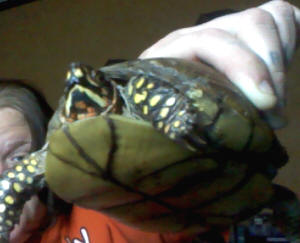 
|
|
Turtle identification -- 10/07/11
Dear Crew,
<Hiya - Darrel here>
We live in Mobile Al and found this turtle in our back yard. We
live close to a large lake. It laid eggs in the ground in the
shade of a pine tree. Can you identify it for us?
<Sure. Her name is Alvis Box. She's 26 years old, daughter
of Henry and Docka Box. She enjoys walks in the moonlight,
70's rock music and male turtles that are not afraid to
cry.>
<Unless you wanted more generic information?>
<What you have there is a Gulf Box Turtle (Terrapene
carolina major) one of THE coolest turtles on the
planet. Smart, friendly and interesting. They are terrestrial
turtles, living around the edges of water and not so much in the
water. They enjoy swimming, but live mostly on land. As adults
they eat mostly vegetables (the same kinds our parents tried to
get us to eat) but will never pass up a snail or an earthworm if
given a chance. They make great pets.>
<You have two choices with the eggs: Leave them where they are
and let nature take it's course - in which case you need to
place a 3 foot wide ring of chicken wire or hardware cloth
fencing (enclose the top, too) to contain the babies when they
hatch next year.>
<-OR- you can dig the eggs up and incubate them yourself with
a much greater chance of the eggs hatching (if they're
fertile, and not all layings are fertile). The trick here is to
GENTLY dig them up, without breaking them or changing their
orientation. It's tricky work '¦ just like the
archeologists you see on TV "digging" 10 foot deep
holes with paint brushes '¦ it takes patience
'¦ but hey, what ELSE were you going to do
tomorrow?
Here is a link on what to do and how to do it: http://wetwebmedia.com/FWSubWebIndex/TurtleReproArtDarrel.htm
>
<If you get babies, write back!!>
|
|
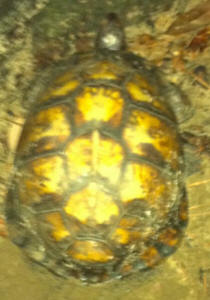
|
|
please help identify turtle 8/24/11
Dear Crew
<Hiya - Darrel here>
We found this turtle on a sandy bay beach on Long Beach Island,
New Jersey and we'd like you to identify it.
<Sure. That's Gary Terrapin. Son of Bill and Marjorie
Terrapin.>
I'd like to know what kind it is. I'm thinking maybe a
Northern Diamondback Terrapin?
<Your guess is spot on- that's exactly what Gary
is>
Also, what should I feed it.
<Diamondback Terrapins need the same things other turtles
need, Kerry- Water, land, basking heat, UV light, love,
understanding, a sense of purpose in life '¦ and a
smart phone with text capabilities!>
<On a more serious note, that little guy starts with the same
basic care and the other hard shelled water turtles as noted
here: http://www.wetwebmedia.com/FWSubWebIndex/RESCareBarton.htm
everything regarding light, heat, temperature gradients, diet,
etc. start out the same, so read and understand thoroughly and
make sure you cover all the conditions>
<Now for a few differences. The Diamondback Terrapins are
brackish-water turtles, which means they live in water that is
saltier than fresh water and yet not as salty as sea water. But
on top of that, they frequently swim in both fresh water AND sea
water. For Gary, you should go to a Marine fish store (or maybe
the ocean if you're close enough) and bring home 5 gallons of
marine water (or seawater) and mix 2 gallons of that per 10
gallons of fresh tap water. That means if you're going to
keep him in a tank with 5 actual gallons of water, make it 4
fresh and 1 saltwater '¦ for the first month or so
while Gary is getting acclimated. Then you can gradually make it
just plain fresh water.>
<Gary's natural diet is more meaty that the Red Eared
Sliders described in the article '¦ in the wild
he'd feed on clams, mussels and crayfish, etc. BUT there is
no evidence that the really need that in their diet '¦
ReptoMin food sticks and decent quality Koi pellets are fortified
with all the vitamins and nutrients a growing turtle
needs.>
<Now the only bad news. SOME wild caught Diamondbacks do not
adapt well to a freshwater-based life with a vegetarian diet.
Gary is young and likely to do just fine, but you should be aware
just the same. The SIGNS will be the same signs as any pet in
captivity - is he active, alert and feeding well? Clear eyes?
Aware of his surroundings? Does he react to you when you approach
him? Running away (fear) is fine, as is looking curiously and
even scrambling toward you in hopes of a meal '¦ but
listless ignoring you and seeming to not know you exist would be
a bad sign. (Unless you've recently had a fight with him and
his feelings are hurt .. then he'll ignore you for a day or
two). Don't over feed him. All the pellets or sticks he can
eat in 5 minutes, 4 days a week. No more. Eating well and wanting
more is another good sign that he is adapting well.>
<See that he gets some natural sunlight, don't let him
have friends over until he's at least 6 years old -- and I
was just kidding about the smart phone -- he'll run up
THOUSANDS of dollars in charges, downloading apps he'd never
use!!>
Thanks!
-Kerry
Sent from my cell phone. Please excuse any typos. :-)
<Sent from my office. Please excuse the insanity!>
|
|
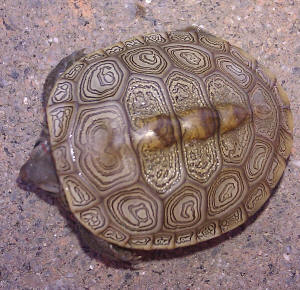 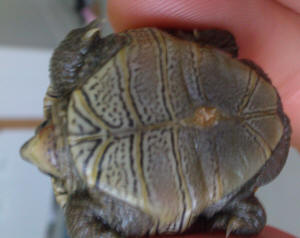
|
|
hieee -- 07/02/11
Hello,
I would like to know what kind of turtle my dad
brought for me. I'm sending its pics. I searched everywhere
but I couldn't get what kind of turtle it is. And I would
also like to know how should I take its
proper care?
<Your photos are too dark and blurry. Do also note that while
we offer a free service in the sense of helping you for no money,
we do ask people send images that are no larger than about 500 KB
in size. Yours were MUCH bigger than that. Don't send the
images straight from the camera. Use your computer to resize them
down to about 800 x 600 pixels, and send that image. In the
meantime, do read here:
http://www.wetwebmedia.com/fwsubwebindex/RESCareBarton.htm
Various Trachemys species are by far the most commonly kept
turtles in the world, especially in the US and Europe. In some
places, e.g., Pakistan, another species, Kachuga smithii, seems
to be popular. Maintenance of most freshwater turtles is very
similar. Do note in particular issues concerning diet (mostly
green foods); basking (needs UV-B light in particular); calcium
(in the diet); and temperature (warm basking spot, 25-30 C, but
unheated water). Turtles themselves are often cheap, but the
stuff they need (vivarium, filter, heat lamp, UV-B light) are
moderately expensive.
Without these things they quickly sicken and die. Cheers,
Neale.>
|
|
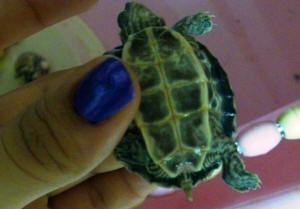 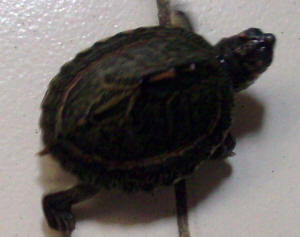
|
|
what kind of turtle is this.
6/23/11
Dear Crew
<Hiya - Darrel here>
My family and I found this little turtle crawling in gravel by
our old apartment.
<Yep>
We have put it in an aquarium and gave him/her rocks and
light.
<Sorry - but NO! An aquarium isn't quite the right
environment. That baby needs a terrarium>
We have been feeding him insects and dried brine shrimp and such
as well as baby turtle food from out local pet store.
<Nope ... Fruits, vegetables, the occasional earthworm or
garden snail>
We would really like to know what he is and if he is going to be
a dangerous little guy/girl .
<Not only not dangerous, but one of the most personable and
friendly turtles you're likely to ever run into>
Please help us identify him/her.
<Her name is Clarissa!>
<Oh wait ... you meant species, etc. didn't you?>
<What you have there is a Terrapene. A baby Box
turtle. When they're babies, they have a normal
(flat-looking) carapace and look just exactly like the little guy
you have there. As She (or he) grows up, the shell becomes much
more domed-looking.>
<Do some research on them starting here:
http://www.wetwebmedia.com/fwsubwebindex/TurtIDSueG3.htm
>
<They are some of the nicest and friendliest turtles ever!!!
Good luck with yours!>
|
|
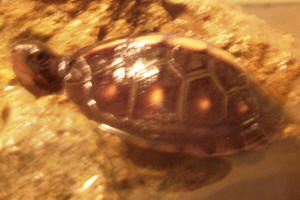
|
|
Found a big turtle in my yard 6/22/11
Good afternoon,
<Hiya - Darrel here>
I found your website doing a search on Google. After reading
through your other posts I only have two questions. Is this
turtle a Yellow Bellied Slider (YBS)?
<She is a BEAUTIFUL Yellow Bellied Slider in great
shape!!!!>
I found this turtle in my back yard which is not close (.5 miles)
to a stream, and the front yard is on a busy road.
<It's possible, I suppose, that it's a long term
captive in your neighborhood that escaped, but whether from a
stream, lake, pond or pool, turtles like that can take INCREDIBLE
walking tours in search of '¦ whatever turtles search
for. I've come across them 3 MILES from the nearest
water.>
Should I just put the turtle back in the yard where I found
him/her, or should I take him/her to the stream in the park?
<What I'd rather you do is look on the Internet for a
turtle & tortoise club in your area. Putting the turtle back
in your yard (allowing it to just walk away) is dangerous and we
never, ever, EVER, *E*V*E*R release an animal into the wild
unless we are absolutely sure beyond question that we are
releasing it back into it's native habitat. An experienced
keeper in your general area will know if that species &
subspecies is a local native and can be safely returned to
it's wild state. More importantly, a guy might drive 100
miles to obtain a turtle that large & that pretty. I know I
sure would.>
I think your website is awesome by the way.
<Thank you, thank you, thank you. We never tire of hearing
that -- and allowing us to take the opportunity to make a
shameless pitch right here in the middle of the daily FAQs
'¦.
Lights, cameras drum roll & LARGE FONT PLEASE
'¦..
Ladies and Gentlemen, if at any time now or in the future you
feel so inclined, there is a "donate" button on the WWM
web site. The donations received go toward paying for articles
and other content that in turn make the web site even more
awesome than before.
<thank you for your attention>
Thanks,
<Yer welcome!>
Jasmine
|
|
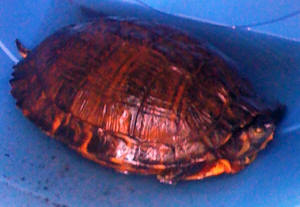 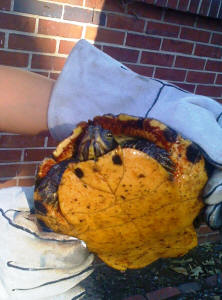
|
|
Trying to Identify Small Turtle about 1" to 1
1/2" 6/1/11
Dear Crew,
<Hiya - Darrel here>
Found following turtle in parking lot near the bay in New Jersey
Shore (Long Beach Island)
See attached two pictures.
Thank you for your help,
Donna Jessie
<Donna '¦ the pictures you sent, 4 in all, have a
certain lack of clarity that make identification difficult. My
first instinct is that you have a Wood Turtle (Clemmys insculpta)
but with such fuzzy pictures, it could also be a automatic choke
assembly for a 1982 Honda Civic.>
<I wish I could be more help '¦ but here's a
link that might help you www.state.nj.us/dep/fgw/ensp/pdf/turtles.pdf
>
Re: Trying to Identify Small Turtle about 1" to 1
1/2" 6/1/2011
Sorry that's the best I could do with the phone.
<It's OK - I just wanted you to know that it's not
that I'm stupid (at least that's not THIS problem!) but
that I just couldn't see>
Do you have a picture of the Wood Turtle that you could send
me??
<yes, I tried to send THIS link the last time www.state.nj.us/dep/fgw/ensp/pdf/turtles.pdf
and it didn't paste properly. Check out the Wood
Turtle>
I went to the pet's store and they advised that they thought
it was a type of snapper turtle.
<Nope. If you look at that little guy's plastron (the
bottom of the shell) you'll see that it's a fully formed
shell with little areas sculpted out for his legs, etc. Snapping
turtles, like Mud & Musk turtles, have very small plastrons
'¦ almost like a cross shape, with HUGE areas for
their arms and legs. It's not a snapper.>
Could you give me an idea of diet.
<Not until we identify. Try the link above (now that I
actually sent it) and let's zero-in on what he is>
Thank you,
Donna
|
|
 .jpg)
.jpg) .jpg)
|
|
|

